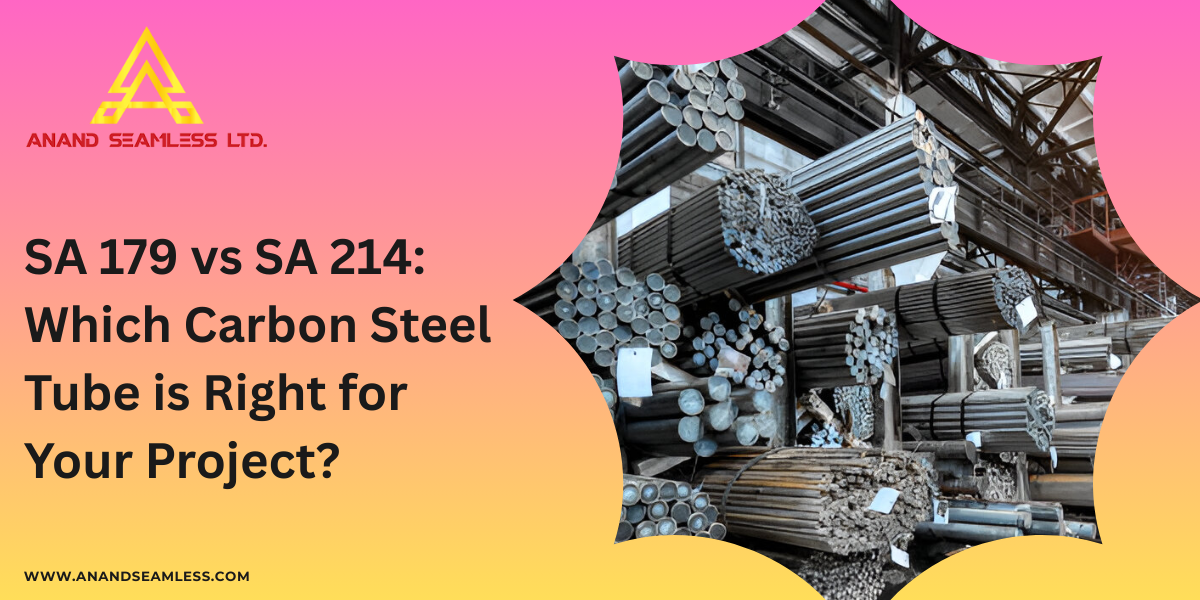Quick Inquiry
In industries such as power generation, oil & gas, petrochemicals, and HVAC, the choice of carbon steel tubes can significantly impact a project’s performance, cost-efficiency, and safety. Among the most commonly used specifications for heat exchanger and condenser tubes are SA 179 and SA 214. While both serve similar purposes, they vary in mechanical properties, manufacturing processes, and suitable applications.
For businesses operating in the seamless tubes segment, understanding the differences between SA 179 tubes and SA 214 tubes is critical for making informed procurement and project decisions.

Overview of SA 179 Tubes
SA 179, also known as ASTM A179 / ASME SA179, is a specification that covers seamless cold-drawn tubes made from low-carbon steel. These tubes are commonly utilized in applications such as heat exchangers and condensers, where high thermal conductivity and efficient heat transfer are essential.
Key Features of SA 179 Tubes:
- Manufacturing Process: Seamless and cold-drawn
- Material Composition: Low carbon steel (typically 0.06–0.18% carbon)
- Outer Diameter: Generally up to 3 inches (76.2 mm)
Wall Thickness: Thin walls for effective thermal conductivity - Tensile Strength: Minimum 325 MPa
- Yield Strength: Minimum 180 MPa
- Elongation: At least 35%
- Temperature Range: Excellent performance in high-temperature environments
Because of the cold-drawn seamless process, SA 179 tubes exhibit superior surface finish, tighter dimensional tolerances, and enhanced mechanical strength, making them ideal for high-performance applications.
Overview of SA 214 Tubes
SA 214, or ASTM A214 / ASME SA214, outlines the standards for electric-resistance-welded (ERW) carbon steel tubes. These tubes are engineered for use in heat exchangers, condensers, and similar systems where heat transfer is a key requirement.
Key Features of SA 214 Tubes:
- Manufacturing Process: Welded (ERW)
- Material Composition: Similar low carbon content to SA 179
- Outer Diameter: Up to 3 inches
- Wall Thickness: Typically heavier than SA 179
- Tensile Strength: Minimum 380 MPa
- Yield Strength: Minimum 205 MPa
- Elongation: Lower than SA 179, around 30%
- Temperature Range: Suitable for moderate to high temperatures
Due to the ERW process, SA 214 tubes are generally more economical than seamless SA 179 tubes but may not offer the same mechanical uniformity or surface finish.
SA 179 vs SA 214: Key Differences
Criteria |
SA 179 Tubes |
SA 214 Tubes |
| Manufacturing Method | Seamless (cold-drawn) | Welded (electric resistance welded) |
| Mechanical Strength | Superior due to seamless construction | Lower, with potential weak weld zones |
| Surface Finish | Smoother and more uniform | May have weld bead irregularities |
| Thermal Conductivity | High due to thinner walls and uniformity | Slightly lower due to thicker walls |
| Dimensional Accuracy | Excellent | Moderate |
| Cost | Higher | More economical |
| Typical Applications | High-performance heat exchangers, boilers | Standard heat exchangers, condensers |
Get in Touch for Expert Tube Recommendations
When to Choose SA 179 Tubes
Given their superior quality and thermal efficiency, SA 179 seamless tubes are ideal for:
- High-Pressure Systems: Where weld seams may be a point of failure.
- High-Temperature Environments: In boilers or superheaters.
- Critical Heat Transfer Applications: Power plants, chemical processing units, and refineries.
- Stringent Compliance Projects: Where meeting specific mechanical standards is non-negotiable.
If your project demands exceptional strength, reliability, and thermal performance, investing in SA 179 seamless tubes is a strategic decision that pays off in long-term durability and efficiency.
When to Choose SA 214 Tubes
SA 214 welded tubes are better suited for:
- Non-Critical Applications: Where performance pressure is moderate.
- Budget-Constrained Projects: Industrial cooling systems, HVAC units, or low-risk heat exchangers.
- Short-Term or Low-Cycle Installations: Where long service life isn’t a priority.
SA 214 tubes can deliver acceptable performance at a lower upfront cost, especially where the risk of weld failure is negligible or manageable.
SA 179 Tube Manufacturer’s Perspective
As a leading SA 179 tube manufacturer in India, we understand the diverse operational requirements of our global clientele. Our SA 179 seamless tubes undergo stringent quality checks and are manufactured using the latest cold-drawn technology, ensuring:
- Dimensional Precision
- Excellent Surface Finish
- Consistent Wall Thickness
- Superior Corrosion Resistance
We cater to a wide array of industries, including power generation, petrochemical plants, shipbuilding, and thermal processing facilities.
Choosing a reliable SA 179 tube manufacturer ensures that your product meets international standards like ASTM, ASME, and DIN, along with optional custom specifications tailored to your project.
Choosing the Right Tube for Your Application
When evaluating SA 179 vs SA 214 for your specific use case, consider:
- Operating Pressure & Temperature: SA 179 excels in high-stress environments, while SA 214 is suited for moderate conditions.
- Cost Considerations: SA 214 may reduce material costs, but can lead to higher maintenance if not properly matched to the application.
- Longevity and Maintenance: SA 179 offers a longer service life and lower chances of failure.
- Regulatory Compliance: For industries bound by stringent mechanical and safety standards, SA 179 tubes are often the preferred—and sometimes required—choice.
Conclusion
Both SA 179 and SA 214 serve vital roles in heat exchanger and boiler systems, but their performance profiles differ significantly due to their manufacturing processes and mechanical properties.
- Choose SA 179 seamless tubes for projects demanding high performance, precision, and durability.
- Opt for SA 214 ERW tubes when cost-efficiency is prioritised, and operating conditions are less extreme.
As a trusted SA 179 tube manufacturer, we help businesses choose the right materials that align with both technical needs and commercial goals. If you’re planning a project and are unsure about which carbon steel tube to select, our team at Anand Seamless Limited is ready to guide you through the decision-making process with industry-specific insights and high-quality product solutions.
Unlock Superior Performance with Premium Seamless Tubes
When your project demands reliability, strength, and precision, settling for anything less than top-tier seamless tubes isn’t an option. At Anand Seamless Limited, we specialise in manufacturing high-performance tubes engineered to meet the toughest industrial standards. From power generation and petrochemical plants to high-pressure boilers and heat exchangers, our products deliver unmatched durability, thermal efficiency, and corrosion resistance.
With decades of expertise and cutting-edge technology, we ensure every tube meets international specifications and your unique project requirements. Our commitment to quality, consistency, and timely delivery has made us a preferred partner for businesses across India and beyond.
Why risk downtime, costly replacements, or safety concerns? Invest in seamless solutions that drive long-term value. Whether you’re upgrading existing infrastructure or launching a new venture, our team is ready to support you with technical guidance, tailored solutions, and dependable service.
Experience the difference with precision-engineered seamless tubes. Contact us at +91-9909232552 or email us your queries at inquiry@anandseamless.com to discuss your project needs and request a customised quote.
lATEST BLOG |
|
Finned Tube Heat Exchanger Selection Guide for Rice Mills, Dairy and Food Plants in India
A finned tube heat exchanger is one of the most im |
|
Why Cold-Drawn Tubes Are the Best Choice for Aerospace Component Manufacturing
When it comes to aerospace manufacturing, the sele |
|
How Seamless Steel Pipes Ensure Safety in High‑Pressure Boiler Systems
When it comes to ensuring the safe operation of hi |
|
Why Seamless Tubes and Pipes Are Gaining Popularity in Heavy-Duty Industries
In the world of heavy-duty industries, where high |
|
How Finned Tubes Help Combat Fouling in Heat Exchangers: Solutions for Clean Heat Transfer
Heat exchangers are the heart of many industrial s |

